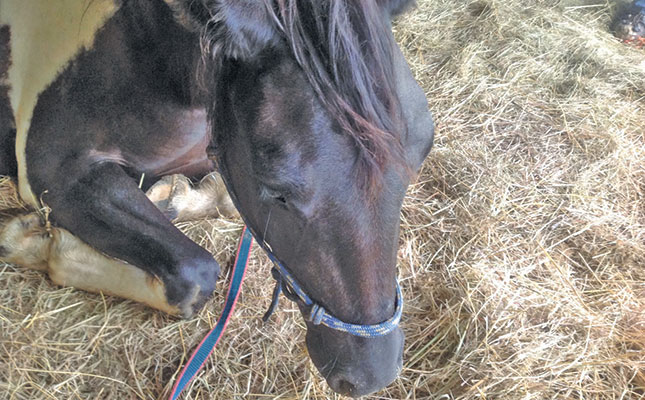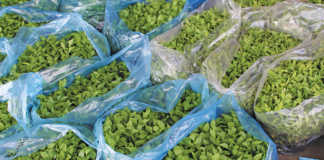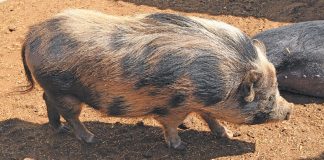
Photo: Prof Cheryl MCcrindle
South Africa’s horse export industry is worth about R250 million. However, should the country be allowed to export horses directly to the EU and other destinations, this could easily reach R1 billion, says Adrian Todd, the managing director of the South African Equine Health and Protocols (SAEHP).
After South Africa failed an EU disease-prevention protocol audit in 2013, direct exports were banned, and horses now face an arduous process to reach international destinations.
This has not only resulted in the loss of revenue for breeders and exporters, but has had a negative impact on South Africa’s horse industry as a whole, as the country’s horses cannot compete on the global stage.
A great threat
The ban on direct exports was put in place in 2013 due to the threat of South African horses taking African horse sickness (AHS) abroad.
South Africa has since implemented a world-class disease-prevention protocol, and has thus eliminated the threat of South African horses spreading AHS to other countries, but the EU has yet to audit the new protocol, and thus the ban remains in place, says Todd.
Despite movement control and diminishing the threat of AHS to horses abroad, it remains a great threat to the local horse population. A highly infectious disease, it is caused by the African horse sickness virus (AHSV), and is often fatal.
There are nine serotypes of the AHSV, all of which are endemic to South Africa. Horses, mules, donkeys and zebra are affected. However, horses are the most severely affected.
The AHS season runs from November to May, with the peak season between February and April. The virus is transmitted by the Culicoides midge.
AHS occurs in three main types: the lung form (dunkop), heart form (dikkop), and the mixed type.
Dunkop is the most severe form, with a mortality rate of 90%, according to the African Horse Sickness Trust.
Horses present with a high fever of 39°C to 40°C (the average temperature for an adult horse is between 36°C and 38°C); difficulty breathing; and a frothy discharge from the nose, which may be accompanied by other symptoms of pulmonary oedema.
Death is often caused by complete respiratory failure, with horses dying as quickly as 24 hours after the onset of fever.
Dikkop has a mortality rate of around 50%. Horses present with fever; swelling of the head and eyes (in severe cases the entire head may swell); loss of ability to swallow and possible colic symptoms; and bleeding of the membranes of the mouth and eyes. The horse may also have symptoms of conjunctivitis, as well as shortness of breath.
Dikkop usually has a slower onset of death, with horses dying four to eight days after the start of the fever.
Horses with the mixed type demonstrate symptoms common to both dunkop and dikkop. According to the World Organisation for Animal Health (OIE), the mortality rate is 70% to 80%.
AHS is a controlled animal disease, and as there are other diseases that may present with similar symptoms, any equine suspected of being infected should be tested. All confirmed and suspected cases must be reported to the state veterinarian, as dictated by law.
Control zones
Certain parts of the Western Cape have been designated the AHS controlled area, which is divided into three zones: the free zone, the surveillance zone and the protection zone.
The controlled area is considered a low-risk area for AHS, and the legislation that governs movement in and out of this area aims to ensure that AHS does not occur here.
The rest of the country falls under the AHS infected zone.
No horse, mule or donkey may be moved into or between zones of the AHS controlled area without a permit or permission from the Boland state veterinarian.
Horses that are moved from the infected zone to the controlled area, or those moving from the protection to surveillance or free zones within the controlled area, must be vaccinated by a registered veterinarian not more than 24 months before the movement of the equine and not less than 40 days prior to the movement. This must be recorded by the vet in the horse’s registered passport.
Registered vaccine
According to Dr Camilla Weyer, veterinary logistics manager at SAEHP, there is only one registered vaccine for AHS in South Africa: the live-attenuated vaccine (LAV), produced by Onderstepoort Biological Products.
No other vaccine has been registered under the Fertilizers, Farm Feeds, Agricultural Remedies and Stock Remedies Act No. 36 of 1947, or the Medicines and Related Substances Act No. 101 of 1965 for the prevention of AHS.
The vaccine consists of two injections that are administered subcutaneously. The second injection must be administered a minimum of three weeks after the first injection. Both injections are vital as they protect the animal against different AHS serotypes.
The LAV has received great criticism over the past few seasons, with concerns about its efficacy being raised.
“The LAV [gives the horse a] weakened infection, which causes an immune response. This [should] provide protection should the horse later be infected with a field virus.
“However, the LAV has the potential to revert to the more virulent strain that it was originally based on, and therefore can potentially cause disease, and be transmitted from the vaccinated horse to a naive [unvaccinated] horse, which will then also get sick, and so the outbreak starts,” says Weyer.
Another potential problem is viral reassortment or recombination, which can occur when two or more viral genomes co-infect the same host cell and exchange genetic segments.
“In viruses with segmented genomes, such as the AHS virus, complete genome segments can be interchanged during viral replication, giving rise to new segment combinations, and therefore essentially different viruses with different characteristics, such as transmissibility or potential to cause disease.”
Weyer says outbreaks have occured in the AHS controlled area due to both reversion to virulence and reassortment.
“However, these outbreaks have so far only been confirmed in the AHS controlled area, where there are large numbers of naive horses and vaccination was occurring during the summer, which is a high-risk time for viral transmission.
“It was these outbreaks that resulted in the closure of the direct exports from South Africa to the EU.”
This has also led to the Director of Veterinary Services issuing a directive to limit the period during which horses may be vaccinated in the AHS controlled area to between 1 June and 31 October.
These times are also recommended for the rest of South Africa, says Weyer.
According to the Department of Agriculture, Land Reform and Rural Development, there were 362 reported cases of AHS from September 2018 to July 2019. Any increase in cases of AHS, however, cannot be attributed to the LAV.
Climate change, which is leading to hotter, drier periods, is having a direct impact on the number of vector populations, she says. “I suspect that we will start seeing more vector-borne outbreaks in the years to come due to global warming,” she says.
Moreover, she adds that the ‘anti-vaccination’ movement is growing, resulting in increased numbers of naive horses, and resulting in lowered herd immunity.
“Increased numbers of naive horse populations will mean an increase in the multiplication potential for the virus. Outbreaks will then be harder to control.”
The combination of these factors could lead to increased outbreak severity and distribution, she says. Despite concerns that the recent outbreak was caused by a new serotype, Weyer says cases that tested positive for AHS this season “did not indicate any new serotype or vaccine involvement as a cause of the outbreaks”.
No alternative
Over the past season, numerous social media campaigns, which can’t be named due to legal implications, have promoted the use of an alternative vaccine, the DCA AHS Vaccine. Disease Centre Africa, the manufacturers of the DCA, says it is a deactivated vaccine, and safer than the LAV.
DCA managing director Dr Daan Goosen says there has been a definite increase in interest in the DCA over the past season.
However, the DCA vaccine is not a registered product, and does not comply with the legal requirement for vaccination under the Animal Diseases Act.
Despite this, many horse owners have actively promoted the use of the DCA vaccine over the LAV. This sets a dangerous precedent, as there is no scientific evidence that the DCA vaccine is effective against AHS, says Dr Pieter Vervoort, the managing director of the National Animal Health Forum.
He adds that the registration of a product implies that it has adhered to the strict scientific and legal regulations required by the governing body.
“People discrediting the LAV have no scientific basis to do so. We know there are limitations to the current vaccine, but it remains an extremely effective vaccine, and the only proven way to protect a horse against AHS.”
Vervoort urges all horse owners to only use the LAV, saying in any instance where it is a legal requirement to vaccinate against AHS, using the DCA vaccine will not be permitted.
While the DCA does not claim that its vaccine has been registered, it does say that it complies with the relevant laws.
Goosen says the vaccine has not yet been registered because of financial and time constraints. He adds that the DCA adheres to strict internal quality assurance to ensure the efficacy of the product.
Prevention
When injecting the LAV, horse owners must ensure that the drug is administered subcutaneously. This is because the body absorbs intramuscular and intravenous drugs more rapidly, leading to a possible adverse reaction to the drug.
It is also recommended that owners take their horses’ temperatures daily four to five days before administering the vaccine, to ensure the animal is healthy and not harbouring another illness before receiving the vaccine.
The agriculture department, as well as the African Horse Sickness Trust and the OIE, recommend that horses be stabled between dusk and dawn. Using insect repellents is vital.
“It’s important to note which fly spray you are using. There are many products out there currently that claim to repel midges, but the only published data to show an effective repellent effect for the Culicoides midges are those containing DEET. It is thus important to ensure that you are using a product that contains this,” says Weyer.
Popular repellents, such as Tabard (for equines) and Buzz Off, do not contain DEET.
Weyer says the movement of horses during outbreaks should also be reconsidered.
However, this could have a negative economic effect on shows and other equestrian events, and therefore the industry as a whole.
“Movement of horses is definitely a part of the problem when it comes to outbreak spread. First, AHS can be subclinical, so you can potentially move the virus around by moving the horse.
“Second, movement can be a stressor for the immune system, therefore increasing the chance of the horse becoming infected if it comes into contact with an infected midge, which could then also lead to subsequent disease if the horse’s immune system is compromised.
“As the virus is vector-borne, it needs the midge to pass the virus on, and so same-day movement to shows from local areas is not likely to be the real problem. The issue is much more likely to be due to long-distance travelling, where horses congregate at the show for a number of days from all different areas of the country and then disperse again.”
Some horse owners also rely on immune-boosting supplements. However, Vervoort says that most of these immune boosters have no basis in scientific evidence, and should not be used as an alternative to vaccination.
Horse owners are also advised to ensure that horses are not kept near standing water, such as dams, as the insect vector breeds here.
A new vaccine
The midge that transmits the disease is also responsible for the transmission of bluetongue in sheep, and it is expected that AHS will move further north at some time or another.
As horses in Europe and the UK have no immunity to the illness, AHS could have a significant impact on the equine industries in these regions, possibly devastating equine populations.
According to The Telegraph, AHS could “take out nine out of 10 horses in the UK”. For this reason, many international equine research centres have devoted a lot of money to AHS research and the development of a safer vaccine. While there seems to be some promising research being done in this regard, no new vaccine will be available within the next few years.
“One of the main stumbling blocks in the development of vaccines for this disease is the fact that we have all nine AHS serotypes present in South Africa, and that means that we need a vaccine that can provide polyvalent protection. This happens to be one of the issues with the LAV. While it does provide a level of polyvalent protection, the response to each serotype is not at the same consistent level.
“South Africa has a number of candidates in the pipeline, but funding of these candidates to get them past the last few levels of research and registration is a major challenge, especially financially. However, we watch this space with growing anticipation,” says Weyer.
However, if and when a new vaccine does become available, it will only be effective when properly used by horse owners.
Email Dr Camilla Weyer at [email protected]











